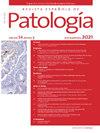病理第二意见的管理:西班牙解剖病理学会(SEAP)的建议。病理第二意见
IF 0.5
Q4 Medicine
引用次数: 0
摘要
随着病理诊断复杂性的增加,主要是癌症诊断,对专业和高质量中心的第二意见的需求也在增加。在进行这些协商、管理所审查的材料和咨询中心的答复的标准方面,有些缺乏统一。材料和方法为了确定病理学家或转诊中心以及病理学家或咨询中心应考虑的方面的建议,来自西班牙解剖病理学学会的一组专家对其他学会的指南和建议以及相关已发表的文章进行了文献综述。在此审查的基础上,建立了协商一致的标准。结果对转诊医师和会诊医师如何管理病理学第二意见提出了建议,包括材料提交和资金方面的建议。结论转诊病理学家和会诊病理学家均应按照标准化的指导方针开展第二意见,包括转诊、差异管理和资金,以确保系统的一致性。本文章由计算机程序翻译,如有差异,请以英文原文为准。
Management of second opinions in pathology: Recommendations of the Spanish Society of Anatomical Pathology (SEAP). Second opinions in pathology
Introduction
As diagnostic complexity in pathology increases, mainly in cancer diagnoses, the demand for second opinions from specialized and highly qualified centres also increases. There is a certain lack of uniformity in the criteria for carrying out these consultations, managing the material under review, and the responses from the consultant centre.
Material and methods
In order to establish recommendations on the aspects to be considered both by the pathologist or referring centre and by the pathologist or consultant centre, a group of experts from the Spanish Society of Anatomical Pathology conducted a literature review of guidelines and recommendations from other societies and relevant published articles. Based on this review, consensus criteria have been established.
Results
Recommendations are provided on how second opinions in pathology should be managed by both the referring and consultant pathologists, including aspects of material submission and funding.
Conclusion
Second opinions should be carried out following standardized guidelines for both the referring and consultant pathologists, covering referral, management of discrepancies, and funding to ensure a consistent system.
求助全文
通过发布文献求助,成功后即可免费获取论文全文。
去求助
来源期刊

Revista Espanola de Patologia
Medicine-Pathology and Forensic Medicine
CiteScore
0.90
自引率
0.00%
发文量
53
审稿时长
34 days
 求助内容:
求助内容: 应助结果提醒方式:
应助结果提醒方式:


